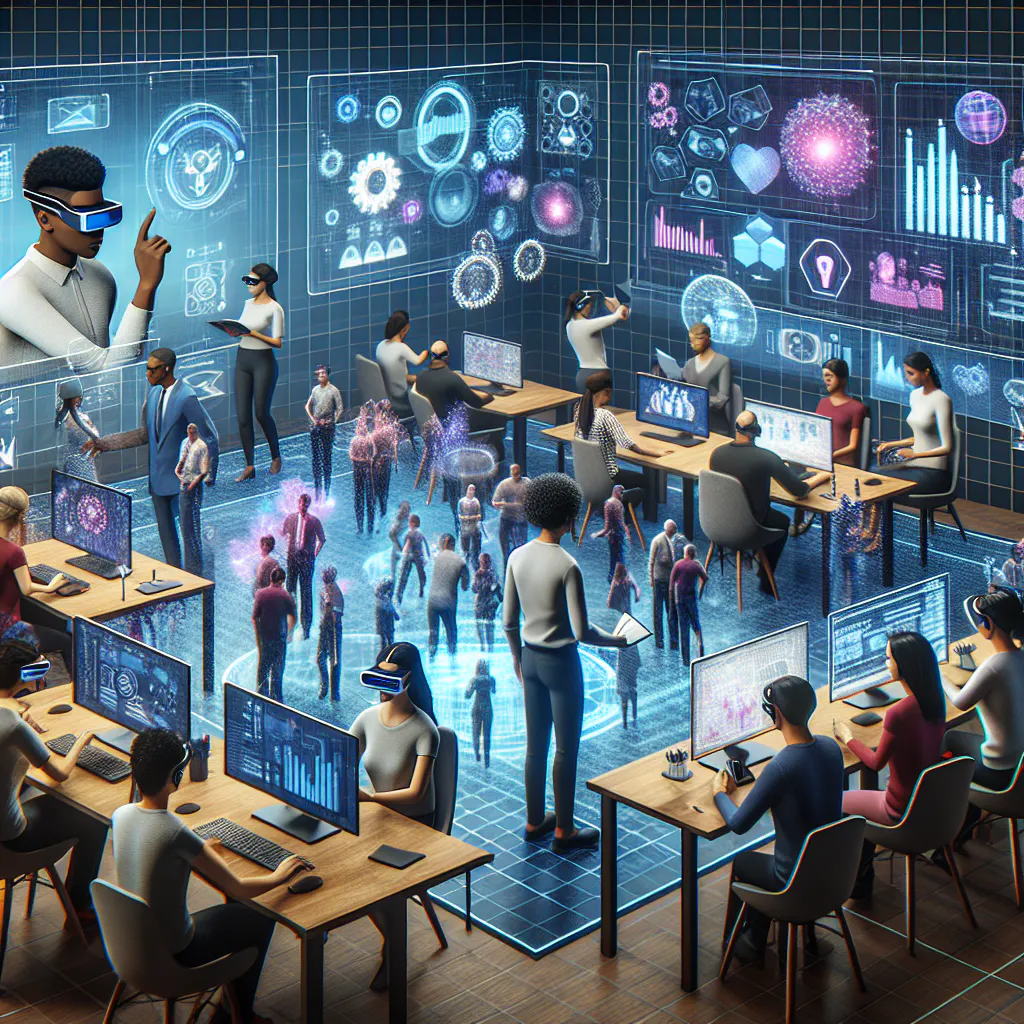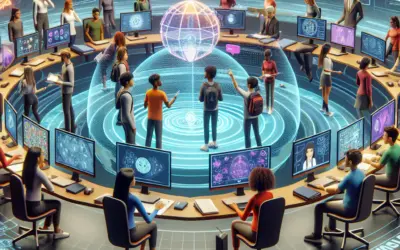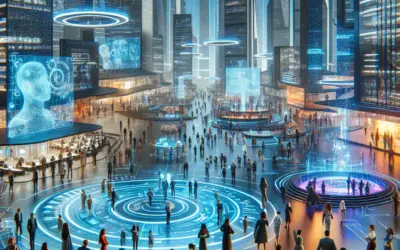Understanding the Metaverse and Its Role in Remote Team Training
The Metaverse, a term that has recently surged into the collective consciousness of
tech enthusiasts and business professionals alike, represents a significant shift in how we
perceive digital interaction. At its core, the Metaverse is a collective virtual shared space,
created by the convergence of virtually enhanced physical reality, augmented reality (AR),
and the internet. This expansive digital realm promises to transform remote team training
by offering a deeply immersive, interactive, and engaging environment where individuals can
learn, collaborate, and innovate like never before.
What is the Metaverse?
Imagine a world where virtual and physical realities blend seamlessly. The Metaverse encompasses
diverse digital landscapes, ranging from social, professional to gaming ecosystems. Each is
rendered in stunning detail and richness, thanks to advanced computer graphics, virtual reality (VR),
and AR technologies. In this ever-evolving domain, users represented by their digital avatars can interact with one another in real-time, engage in experiences, share content, and create new realms.
Metaverse Platforms for Remote Team Training
In the domain of remote team training, Metaverse platforms provide a unique opportunity to conduct
immersive sessions that can mirror real-world scenarios or transcend them with hyper-realistic
simulations. Companies can tailor their training programs to the specific needs of their workforce,
leveraging the Metaverse’s flexibility to break free from geographical constraints and time zones.
Whether it’s conducting a role-play session, a collaborative task, or a complex simulation,
the Metaverse’s infinitely customizable environments ensure that teams can practice and
improve their skills in conditions that were previously impossible to create in the physical realm.
The Benefits of Metaverse-aided Remote Team Training
- Enhanced Engagement: The immersive nature of the Metaverse ensures that team members
are engaged and active participants in the training process, leading to improved retention and application
of new skills. - Scalable Learning Environments: With the ability to accommodate countless participants,
the Metaverse overcomes the physical limitations of traditional training venues. - Real-time Collaboration: Remote teams can collaborate in the Metaverse as if they were in the
same room, strengthening team dynamics and cooperation. - Ready Accessibility: Teams scattered across the globe can access Metaverse training sessions
with nothing more than a VR headset and an internet connection, providing a level playing field for all participants.
The Metaverse is forging new frontiers in remote team training, harnessing the power of immersive experiences
to enrich professional development and teamwork. As organizations strive to adapt to the digital era, the Metaverse
stands out as a critical tool in shaping the future of work and collaboration. Its potential in creating impactful
and memorable training experiences is boundless, offering a glimpse into the transformative effect of VR and AR
on workplace learning and development.
Exploring the Benefits of Metaverse Environments for Team Collaboration
Enhancing Creative Brainstorming with Metaverse Engagement
The metaverse fosters a unique space where team members can collaborate creatively beyond the constraints of the physical world. Here, spatial computing and virtual reality tools enable teams to model and manipulate ideas in a shared digital environment. The immersion offered by the metaverse can spark inspiration and facilitate imaginative brainstorming sessions that are not bounded by office walls. This expansive setting encourages an out-of-the-box approach to problem-solving, fostering a culture of innovation and a feeling of connectedness among remote team members.
Interactive Workspaces and Real-time Collaboration
Interactive workspaces within the metaverse serve as the cornerstones for real-time collaboration. Team members can interact through their avatars, share documents, and co-create within these tailor-made digital environments. Such interactive sessions engage participants more deeply than traditional video calls or chatrooms, promoting active participation and dynamic exchanges.
Building a Sense of Presence with Virtual Reality Meetings
Virtual reality meetings within the metaverse grant a distinct sense of presence that bridges the gap between remote workers. Through the use of VR headsets, participants enter a shared space where body language and non-verbal cues add depth to communications. This intricate layer of interaction creates a sensation of sharing an office, enhancing team cohesion and mutual understanding.
Harmonizing Remote Work with Instant Virtual Meetings
With no need for physical travel, the metaverse simplifies the act of gathering team members from various locations into a single virtual meeting room. These instant connections bypass geographical barriers, which not only saves on travel costs and time but also contributes to a more sustainable and eco-friendly work model.
Implementing Training and Simulation Programs in the Metaverse
The metaverse shines in its ability to host sophisticated training and simulation programs. Teams can participate in skill development exercises in controlled yet realistic virtual settings, which accelerates the learning curve and improves performance. Immersive simulations for high-stakes scenarios allow teams to practice and perfect their strategies without real-world risks.
Seamless Integration of New Team Members
Onboarding new staff is made more efficient through the use of metaverse environments. New employees can explore company culture, interact with virtual mentors, and get acquainted with team dynamics before ever stepping foot into a physical office. This can lead to a smoother transition and a more engaged workforce from the outset.
Enhancing Team Flexibility and Work-Life Integration
Lastly, metaverse platforms contribute to a more flexible work-life blend. Teams can adapt their work environment to fit individual preferences, bolstering morale and productivity. Such flexibility can improve job satisfaction and reduce the burnout rates often associated with remote work.
Embracing Asynchronous Work Cultures
Moreover, the metaverse supports asynchronous work cultures by providing a persistent world where contributions can be made at any time, from anywhere. This allows team members to work during their peak productivity periods and to manage personal obligations without compromising their professional responsibilities.
Step-by-Step Guide to Implementing Metaverse Training for Your Remote Workforce
Understanding the Basics of Metaverse Training
The term ‘Metaverse’ is more than a buzzword; it represents a virtual space where employees can interact, learn, and work collaboratively, despite physical distances. To kick-start your journey in Metaverse training, understanding the underlying technology is crucial. Simple immersive sessions using Virtual Reality (VR) and Augmented Reality (AR) tools can help your team adapt to the Metaverse environment. Begin by educating your workforce about the potential and capabilities of the Metaverse, ensuring they understand how to navigate and engage within this new realm.
Identifying the Right Metaverse Platform
Selecting an appropriate Metaverse platform depends on your team’s size, the complexity of the training needed, and the level of interactivity required. Factors to consider include scalability, security, ease of use, and compatibility with existing systems. Briefly, consider platforms like VRChat or AltspaceVR for more social and collaborative experiences, or proprietary solutions for tailored training modules.
Familiarizing With Virtual Space Interactions
Practice makes perfect. Conduct regular sessions for your teammates to familiarize themselves with the virtual space. Simple tasks such as creating avatars, navigating virtual environments, and using virtual tools can significantly reduce the initial learning curve and prepare your workforce for more complex training modules.
Designing and Developing Tailored Metaverse Training Modules
With a grasp of the basics, the next step is to design training sessions relevant to your company’s needs. Create interactive and engaging content that resonates with your team’s daily tasks for increased retention and real-world application. Incorporate interactive elements such as quizzes, hands-on simulations, and collaborative projects that can be executed within the platform. Investing time in proper instructional design will yield effective and impactful training modules tailored for the Metaverse.
Crafting Realistic Scenarios
Realistic scenarios where employees can practice and hone their skills are vital. For instance, a customer service team can role-play in a virtual setting to refine their conflict resolution skills with avatars that simulate different customer types. Such interactive scenarios can dramatically boost your team’s practical abilities in a controlled, risk-free environment.
Utilization of Gamification Techniques
Integrating gamification elements such as points, badges, and leaderboards can add a fun aspect to the training while fostering a competitive and motivating atmosphere. Gamified learning has been proven to enhance participation and retention, serving as a potent tool in your Metaverse training arsenal.
Establishing Effective Feedback and Reporting Mechanisms
Feedback is a cornerstone of successful training programs. In the Metaverse, providing instant, actionable feedback can transform the learning experience. Use virtual training sessions to give direct feedback on employee performance, catering to visual and experiential learning preferences. Additionally, implement quality analytical tools within your Metaverse platform to report progress, which helps in fine-tuning the training for optimal results.
Setting Measurable Goals and Milestones
It’s essential to set clear and measurable goals for your Metaverse training program. Establish specific milestones that employees can aim for. Measurable outcomes not only guide the training progression but also provide your team with a sense of accomplishment as they reach each milestone. This approach not only encourages continuous improvement but also allows for tracking and assessing the tangible benefits of the training.
Continuous Improvement through Regular Assessments
Regular assessment of the training modules and content ensures that your Metaverse training stays relevant and effective. Use feedback and performance data to make informed decisions on content updates and training methods. This ongoing refinement cycle is critical for keeping the training program aligned with both technological advancements and evolving corporate objectives.
Consolidating Metaverse Training with Traditional Methods
The Metaverse offers innovative ways to train your remote workforce, but it does not replace traditional training methods outright. Instead, leverage the strengths of both worlds by combining them effectively. For instance, supplement virtual training sessions with video conferencing for Q&A discussions, or follow-up with in-person workshops when possible. This hybrid approach ensures a comprehensive training strategy that caters to diverse learning styles and reinforces key concepts across multiple platforms.
Integrating Metaverse Training into Existing L&D Programs
Maximize the impact of your Metaverse training by integrating it into your company’s established Learning and Development (L&D) programs. Align Metaverse experiences with your L&D objectives for a seamless blend of virtual and traditional learning environments. The cohesion between both methods strengthens the overall curriculum, enriching your workforce’s capabilities and knowledge retention.
Encouraging Continuous Learning and Exploration
Encourage a culture of continuous learning within your organization by providing resources and support for employees to explore and engage with the Metaverse beyond formal training sessions. This fosters a proactive mindset towards professional development and keeps your workforce ahead of the curve in an ever-evolving digital landscape.
Measuring the Impact of Metaverse Training on Remote Team Performance and Engagement
As the concept of the Metaverse gains traction, businesses are exploring its potential in training remote teams. The immersive, 3D experience can offer a richer, more engaging learning environment for individuals dispersed across the globe. But how do we gauge its effectiveness on performance and engagement? Metaverse training holds the promise of bridging the gap of physical distance, yet the true measure of its impact lies in both quantitative performance metrics and qualitative feedback on engagement levels from teams.
Quantitative Performance Metrics
Objective data provides a solid foundation for evaluating the efficacy of Metaverse training. By tracking progress through benchmark assessments before and after training sessions, employers can analyze improvements in skills and knowledge. Other performance indicators include completion rates of tasks, speed of execution, and quality of work produced. These data points offer insights into the learning curve and retention rates heightened by Metaverse training methods.
Qualitative Feedback on Engagement
Aside from numbers, personal feedback from team members is invaluable. Are employees finding the Metaverse training more engaging than traditional methods? Surveys and interviews can reveal how the virtual interactions and collaborations are affecting team dynamics and motivation. Employee satisfaction, retention, and overall morale are also significant indicators of the success of Metaverse training programs.
Long-term Impact on Team Cohesion
In the long run, the true test of Metaverse training’s impact may be seen in the endurance of team performance and the continued engagement of remote workers. Improved communication, a stronger sense of community, and decreased feelings of isolation among remote team members could be lasting benefits. Regular follow-ups and continued data analysis will help organizations refine training methods for maximum effectiveness.
Incorporating Metaverse Training into Remote Work Practices
To fully realize the potential of Metaverse training, it must be seamlessly integrated into existing remote work practices. Balance is essential – while some may enjoy and benefit from a fully immersive Metaverse experience, others might prefer a blend with more traditional digital tools. Regularly assessing and adapting this balance to fit team needs is crucial for sustaining high levels of performance and engagement.













0 comentarios